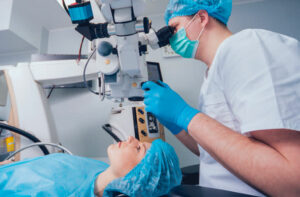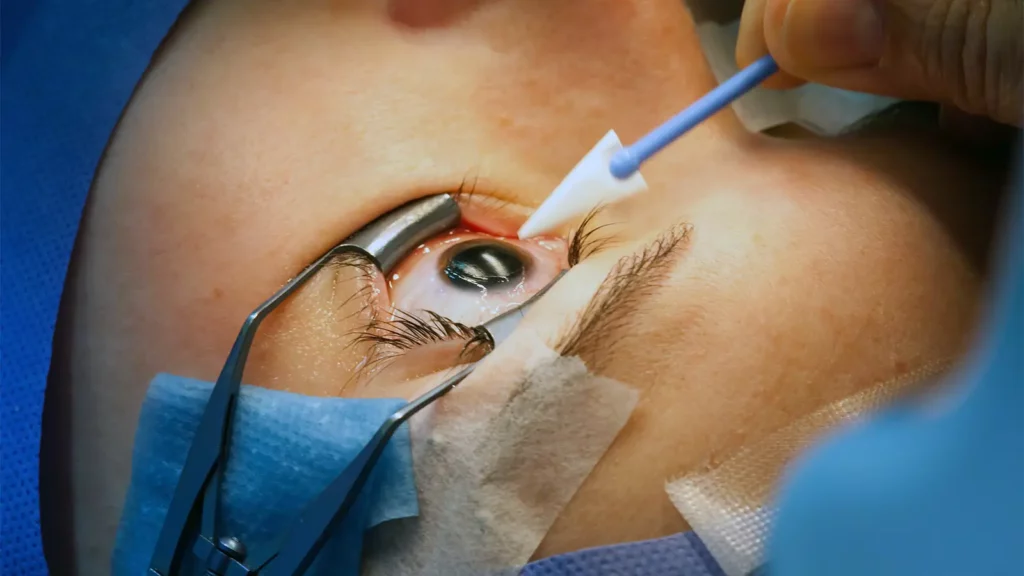Cataract is a common eye condition that affects millions of people worldwide. While cataract surgery is a well-known treatment option, many people are unaware of clear lens exchange (CLE) surgery. In this blog, we will discuss the procedure of CLE. We will also explore the benefits, drawbacks, and different surgical options of CLE, as well as who might be a good candidate for the procedure.
Contents
What Is Clear Lens Exchange?
Clear lens exchange (CLE) is a surgical procedure where the natural lens of the eye is removed and replaced with an artificial intraocular lens (IOL). This procedure is often performed on patients who have cataracts or high levels of myopia (nearsightedness) and cannot achieve clear vision with glasses or contact lenses. CLE is also sometimes referred to as refractive lens exchange or lens replacement surgery.
Procedure Of Clear Lens Exchange
 Clear lens exchange (CLE), also known as refractive lens exchange or lens replacement surgery, is a procedure where the natural lens of the eye is removed and replaced with an artificial intraocular lens (IOL). Here are the steps involved in the CLE procedure:
Clear lens exchange (CLE), also known as refractive lens exchange or lens replacement surgery, is a procedure where the natural lens of the eye is removed and replaced with an artificial intraocular lens (IOL). Here are the steps involved in the CLE procedure:
- Pre-operative evaluation: The first step is a comprehensive eye exam to determine if you are a good candidate for CLE. This will involve measurements of the cornea, lens, and eye length to determine the appropriate power of the IOL to be used.
- Anesthesia: CLE is usually performed under local anesthesia with sedation. This means that you will be awake during the procedure but will be given medication to help you relax and feel comfortable.
- Incision: A small incision is made in the cornea to allow access to the natural lens of the eye.
- Lens removal: The natural lens of the eye is then removed using a technique called phacoemulsification. A small probe is inserted into the eye that uses high-frequency sound waves to break up the lens into tiny pieces. The pieces are then suctioned out of the eye.
- IOL insertion: Once the natural lens has been removed, an artificial IOL is inserted into the eye. The IOL is folded or rolled up to fit through the small incision and then unfolds once it is inside the eye.
- Incision closure: The incision in the cornea is self-sealing and usually does not require stitches.
- Post-operative care: After the procedure, you will be monitored for a short time in the recovery room before being released to go home. You will need to use eye drops for a few weeks to prevent infection and inflammation, and you will need to avoid rubbing or touching your eye.
Surgical Options For Clear Lens Exchange (CLE)
 There are four main surgical options for clear lens exchange (CLE):
There are four main surgical options for clear lens exchange (CLE):
- Phacoemulsification: This is the most commonly used technique for CLE. In this procedure, a small incision is made in the cornea and a tiny ultrasound probe is inserted to break up the natural lens. The lens fragments are then suctioned out of the eye, and an artificial intraocular lens (IOL) is implanted to replace the natural lens.
- Extracapsular cataract extraction (ECCE): This is an older technique that is still used in some cases. In ECCE, a larger incision is made in the cornea and the front of the lens capsule is removed, leaving the back portion intact. The lens is then manually removed through the incision, and an IOL is implanted.
- Femtosecond laser-assisted CLE: This technique uses a laser to make precise incisions in the cornea and lens capsule, allowing for more precise removal of the natural lens and implantation of the IOL. This technique is less commonly used than phacoemulsification but may be preferred in certain cases.
- Refractive lens exchange (RLE): RLE is a form of CLE that is used primarily to correct refractive errors. Such as myopia or hyperopia. In RLE, the natural lens is removed and replaced with an IOL that is designed to correct the refractive error. This technique is typically used in younger patients who are not good candidates for LASIK or other vision correction procedures.
The choice of technique will depend on factors such as the patient’s age, overall health, and the severity of their refractive error or cataracts.
What Are The Advantages Of Clear Lens Exchange?
 Clear lens exchange (CLE) has several advantages over other vision correction procedures, including:
Clear lens exchange (CLE) has several advantages over other vision correction procedures, including:
- Improved vision: CLE can provide excellent vision correction for patients with cataracts or high levels of myopia. Also, it can fit those who are not good candidates for other procedures such as LASIK or PRK. Hence, patients can experience significant improvement in their vision.
- No cataracts: In cataracts, the natural lens of the eye becomes cloudy and causes cataracts. Patients who undergo CLE do not develop cataracts in the future.
- Long-lasting results: The IOLs used in CLE are designed to last a lifetime. This means that patients will not need additional procedures in the future.
- Fast recovery: Most patients can resume normal activities within a few days of the CLE procedure. As a result, my vision continues to improve over the following weeks.
- Reduced dependence on glasses or contact lenses: Patients who undergo CLE may be able to reduce their dependence on glasses or contact lenses. Or, they may even eliminate the need for them.
What Are The Disadvantages Of Clear Lens Exchange?
 While clear lens exchange (CLE) has many advantages, there are also some potential disadvantages and risks. All this should be considered before deciding to undergo the procedure. These include:
While clear lens exchange (CLE) has many advantages, there are also some potential disadvantages and risks. All this should be considered before deciding to undergo the procedure. These include:
- Cost: CLE can be expensive, and it is not always covered by insurance. Patients should consider the cost of the procedure and any associated expenses such as follow-up care and medications.
- Recovery efforts: While recovery from CLE is generally fast, patients may need to avoid certain activities. Such as driving or heavy lifting for a few days after the procedure.
- Potential for visual side effects: Although rare, some patients may experience visual side effects. Such as halos or glare after the procedure, particularly in low-light conditions.
- Need for additional procedures: While the artificial intraocular lens last a lifetime, some patients may require additional procedures in the future if the IOL is damaged or if they develop other vision problems.
- Loss of accommodation: In this procedure, the natural lens of the eye is removed. This can result in a loss of accommodation (the ability of the eye to adjust focus from near to far). This means that patients may still need reading glasses or bifocals to see clearly at close distances.
How Can I Find Clear Lens Exchange Near Me?
 There are several ways to find clear lens exchange (CLE) services near you, including:
There are several ways to find clear lens exchange (CLE) services near you, including:
- Search online: You can search online for eye centers or clinics that offer CLE services in your area. Use search engines such as Google, Bing, or Yahoo, and enter relevant keywords such as “CLE surgery near me” or “clear lens exchange surgeon in [your city or state]”. You may also find online directories and reviews from previous patients to help you choose the right provider.
- Recommendations from friends and family: Ask friends, family members, or colleagues who have undergone CLE for recommendations. They can share their experiences with the procedure and provide insight into the quality of care they received.
- Referrals from doctors: Your primary care physician can refer you to a specialist who performs CLE in your area. They can also provide more information on the procedure, its risks, and benefits. Also, see whether it is suitable for your specific vision needs.
- Insurance provider: Check with your insurance provider to see if they cover CLE services. Also, check which eye centers or clinics are in their network. If you have insurance coverage, they may also provide a list of approved providers in your area.
Conclusion
Clear lens exchange (CLE) is a safe and effective procedure to correct vision problems and improve the quality of life for many patients. While CLE is not right for everyone, it may be a good option for those who are experiencing age-related vision changes, have a high degree of myopia or hyperopia, or have early-stage cataracts. It is important to consult with an experienced eye doctor to determine whether CLE is right for your individual needs. If you are experiencing vision problems, seek help from an eye doctor to explore your treatment options.
Lasik surgery is a safe 10-minute procedure to help you get rid of glasses. EyeMantra offers the most advanced LASIK options including PRK, Femto LASIK, SMILE surgery, Standard LASIK, ICL, and Contoura vision. If you have any questions on LASIK surgery in Delhi, Lasik surgery cost, and Lasik procedure, call us at 9711116605 or email at [email protected].


